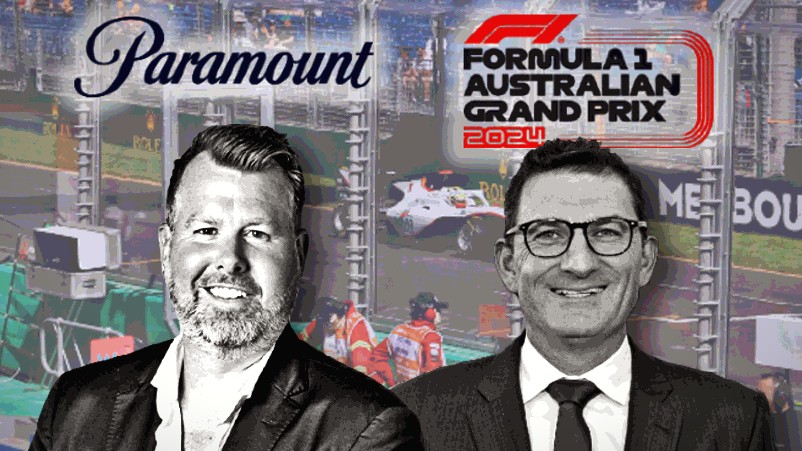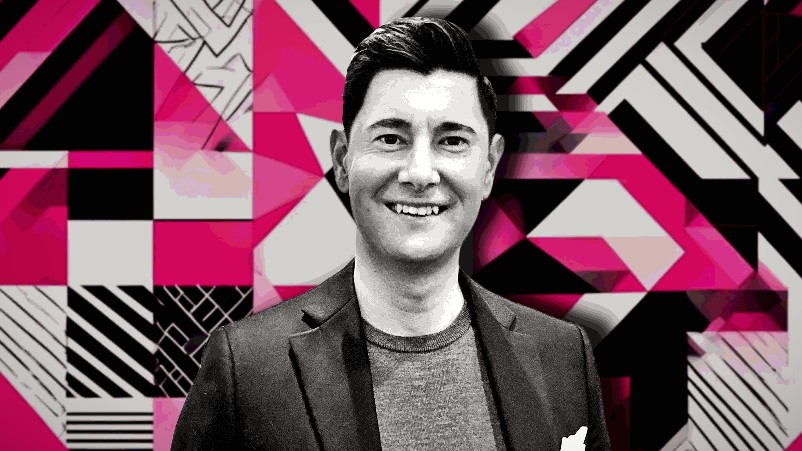After record year, Australian Grand Prix CEO grapples with CX maths: How to fit more people into event without killing experience? Paramount ad sales GM says brands likewise queuing up

The Formula One Australian Grand Prix is fresh off another record breaking year of attendance that Australian Grand Prix CEO Travis Auld hopes signals the event's endurance in the Australian sporting landscape. But he says evolving off-track entertainment – and working out how to get more people into the event without ruining it – are key to putting it into the same league as the Australian Open. Paramount ANZ's GM of ad sales, Nick Bower, says local brands are queueing for sponsorships despite restrictions. He's hoping Paramount still holds the rights in three years time.
What you need to know
- The Formula One (F1) Australian Grand Prix (AGP) is powering, with another record year of attendance at Melbourne’s Albert Park over the weekend.
- AGP CEO Travis Auld is looking to mirror the success of the Australian Open, drawing comparison between both sport’s broad appeal via supporting festivities and activations.
- The AGP is catering to F1’s shifting demographics – with women now making up 40 per cent of Australian attendees – by building out the event’s festivities. Auld says these must continue to evolve if the AGP is to keep growing.
- 40 local partners signed onto the event this year, plus broadcast sponsors. Paramount and Network Ten – GM ad sales Nick Bower says commercial interest has been “stronger than ever”.
- The race coverage reached 1.55 million, with BVOD viewership during the race up 51 per cent. That compare's to 2.8 million reach for Sunday night stalwart Married At First Sight.
- As the “surge” of Formula One interest brought by Netflix's Drive to Survive slowly wears off, Auld says that the continued success of the event comes down to the willingness of Victorians to get behind a big event.
- Keeping that interest, and finding a way to fit more people into the park, will be key to maintaining the current momentum.
We’ve got to keep all of that off-track stuff fresh, relevant, interesting [and] suiting the demographic, because that will ultimately be what drives all the investment back into the on-track stuff.
The Formula One Australian Grand Prix (AGP) is cementing itself amongst Australia’s tentpole sporting events, with another year of record attendance at Melbourne’s Albert Park over the weekend; 452,000 punters came through the gates over the four-day extravaganza. And then slowly made their way back out.
The organisers expect the event to match the $125 million it brought into the Melbourne economy in 2023, with brands likewise piling in both on site and on air. Around 40 businesses and brands took a piece of this year’s local sponsorship lineup and others have aligned themselves with the race through broadcast on Paramount and Network Ten.
While momentum has tempered slightly since the pent-up return of the event post-Covid in 2022 – when three years of anticipation and a refreshed audience demographic curtesy of Netflix’s Drive to Survive saw the Australian Grand Prix (AGP) sell-out four months in advance for the first time ever – hopes remain high that the event will remain a staple in Australia’s annual sporting calendar.
But AGP CEO Travis Auld knows that standing still is not an option.
The next Australian Open?
Auld wants to put the AGP on the same kind of pedestal as the Australian Open (AO), which this year saw 1.02 million fans attend across a fortnight of competition.
Like the AO, Auld says Formula One has a core base of ‘avid fans’ that will turn out year in and year out, but that it’s the off-track festivities that bring in the extra dollars that make the event stand “on its own two feet”. The AO, he says, “no longer relies on Australians playing every year” – and that’s how Auld envisages the Australian Grand Prix.
“We’ve got to keep all of that off-track stuff fresh, relevant, interesting [and] suiting the demographic, because that will ultimately be what drives all the investment back into the on-track stuff.”
Globally, F1 is backed by a suite of heavyweight sponsors and while some of these translate to the Australian competition, like AGP naming rights partner, Rolex, local partnerships are key.
The local lineup represents brands that stray far from the traditional auto alignment, including Mecca Max, Chemist Warehouse, Coates, Crown Resorts, Red Energy, San Pellegrino, Lavazza, Marriott Bonvoy, and St Hugo. The event also receiving major support from the Victorian Government – Visit Victoria CEO Brendan McClements earlier this year outlined its push to become "Australia's natural home for major events".
On site there’s a strong presence from Melbourne’s hospitality scene, with Auld underlining the importance of tapping into the city’s famed food, wine, and fashion cultures to broaden the event’s appeal “outside of [the F1] box” and cater to an evolving audience that is increasingly skewing towards women and families. Women now make up almost 40 per cent of attendees over the weekend – 10 percentage points above the global gender split.
I think if you look at Formula One globally, right now, interest is off the charts and there's certainly the same here in Australia.
Advertisers lining up
The broadening demographics of the F1 audience are a welcome shift for broadcast partner Network Ten, which has aired the race locally for 26 years.
Over the weekend, the broadcast recorded a national reach of 3.2 million, with 1.55 million tuning in to the race on Sunday per VOZ - that's up 3 per cent on last year.
Paramount ANZ’s general manager of ad sales, Nick Bower, nods to F1’s “bravery” in green lighting a production like Drive to Survive, which has pumped interest from audiences and advertisers alike.
But he says the continued growth of the F1 comes down to “courageous decisions in the boardroom” post Liberty Media’s acquisition of the sport’s commercial rights in 2016.
“Not only did they have the courage to open their doors up for Drive to Survive”, says Bower, but when those audiences arrived, they saw a “better” and “more dynamic” product.
Network Ten has also invested in improving its own broadcast, with Drive to Survive fan-favourite Guenther Steiner the crowning jewel in its commentary team. That investment has translated to what Bower says is “stronger” commercial demand than ever.
“I think if you look at Formula One globally, right now, interest is off the charts and there's certainly the same here in Australia,” says Bower. “We’ve got our broadcast rights up until 2026 and we hope that they will continue.”
Ten’s broadcast partners for the 2024 coverage included 7-Eleven, Harvey Norman, Salesforce, Shannons, Subway, Bob Jane and Universal Pictures, adhering to the “pretty tight” restrictions on who can take part.
Those restrictions, which require Network Ten to give preference to global sponsors before going to the local market, also push opportunities for commercial integration to the broadcaster’s shoulder programming.
“Once we're into a live race or live qualifying there are additional restrictions,” says Bower, pointing to live crosses, interviews and news coverage as the avenues through which brands can “really tell their stories” and “connect” with audiences.
The broadcast’s day time airing this year at 1.55 million compares to Sunday evening stalwart Married at First Sight on Nine's 2.8 million and its own launch episode of I’m A Celebrity… Get Me Out of Here! with 1.8 million. Though, with BVOD viewership during the race already up 51 per cent on 2023, it’s likely that final tallies might shift when the week’s consolidated figures come through.
Sitting in the Paddock here you see people walk past, like team principals – you wouldn’t have known who they were five years ago and now they’re a household name.
Melbourne to thank for sustained momentum
Beyond sponsors, Auld says it’s the support of the locals that ensure the continued momentum of the AGP, which has allowed his team to make the most of the opportunity granted by Formula One’s Netflix fame.
“The initial surge [in interest] comes from Drive to Survive and its ability to connect people with drivers. People feel like they know their drivers, they feel like they know the team principles, and so then you've got that narrative that you're following,” says Auld.
“Sitting in the Paddock here you see people walk past, like team principals – you wouldn’t have known who they were five years ago and now they’re a household name.”
Now in its sixth season, Drive to Survive has created the foundations for Melbourne’s latest sporting obsession, with attendance up 50 per cent since the show’s 2019 launch.
“If you can stage a big global event in Melbourne, Melburnians, Victorians and Australians will get behind it – that’s just how the city works,” says Auld.
With the Australian Grand Prix Corporation having secured its rights to host the event up until at least 2035 – the longest contract of any F1 promoter globally – Auld reiterates that success will hinge on the event’s continued evolution. Relevance, he says, is everything.
“Yes, the base is the same and we’ve got to look after those people that are avid F1 fans, but everything else around it has to evolve – the experience has to evolve, the narrative has to evolve.”
Part of this, says Auld, will be figuring out a way to get more people down to the track without hindering the experience – the current capacity for the Albert Park Circuit stands at 130,000.
“We could fit more people in the park, but we don’t want to impact the experience. We want people to be able to get in and out, get to and from public transport, to get something to eat and drink, and still enjoy it. Otherwise, if you get too greedy, then you'll get a short-term blip, but in the long term you’ll impact the event.”


